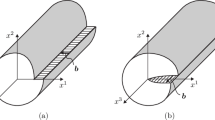Abstract
Defects are ubiquitous in nature, for example, in the form of dislocations, shocks, bores, or impurities of various kinds, and their descriptions are an important part of any physical theory. But the following question can be asked. What types of defect are allowed, and what are their properties if maintaining integrability within an integrable field theory in two-dimensional space-time is required? We consider a collection of ideas and questions connected with this problem, including examples of integrable defects and the curiously special roles played by energy-momentum conservation and Bäcklund transformations, solitons scattering on defects, and some interesting effects in the framework of the sine-Gordon model, defects in integrable quantum field theory, and the construction of transmission matrices. In conclusion, we remark on algebraic considerations and future research directions.
Similar content being viewed by others
References
R. H. Goodman, P. J. Holmes, and M. I. Weinstein, Phys. D, 161, 21–44 (2002).
P. Bowcock, E. Corrigan, and C. Zambon, Internat. J. Mod. Phys. A, 19(Suppl. 2), 82–91 (2004); arXiv:hepth/0305022v2 (2003).
P. Bowcock, E. Corrigan, and C. Zambon, JHEP, 0508, 023 (2005); arXiv:hep-th/0506169v2 (2005).
E. Corrigan and C. Zambon, J. Phys. A, 37, L471–L477 (2004); arXiv:hep-th/0407199v1 (2004).
P. Bowcock, E. Corrigan, and C. Zambon, JHEP, 0401, 056 (2004); arXiv:hep-th/0401020v1 (2004).
E. Corrigan and C. Zambon, JHEP, 0707, 001 (2007); arXiv:0705.1066v1 [hep-th] (2007).
E. Corrigan and C. Zambon, J. Phys. A, 42, 475203 (2009); arXiv:0908.3126v1 [hep-th] (2009).
G. Delfino, G. Mussardo, and P. Simonetti, Phys. Lett. B, 328, 123–129 (1994); arXiv:hep-th/9403049v2 (1994); Nucl. Phys. B, 432, 518–550 (1994); arXiv:hep-th/9409076v1 (1994).
R. Konik and A. LeClair, Nucl. Phys. B, 538, 587–611 (1999); arXiv:hep-th/9703085v2 (1997).
A. B. Zamolodchikov and Al. B. Zamolodchikov, Ann. Phys., 120, 253–291 (1979).
E. Corrigan and C. Zambon, J. Phys. A, 43, 345201 (2010); arXiv:1006.0939v1 [hep-th] (2010).
A. G. Izergin and V. E. Korepin, Commun. Math. Phys., 79, 303–316 (1981); F. A. Smirnov, Internat. J. Mod. Phys. A, 6, 1407–1428 (1991).
E. Corrigan and C. Zambon, Nucl. Phys. B, 848, 545–577 (2011); arXiv:1012.4186v1 [hep-th] (2010).
R. Weston, “An algebraic setting for defects in the XXZ and sine-Gordon models,” arXiv:1006.1555v2 [math-ph] (2010).
M. Jimbo, “Introduction to the Yang-Baxter equation,” in: Braid Group, Knot Theory, and Statistical Mechanics (Adv. Ser. Math. Phys., Vol. 17, C. N. Yang and M.-L. Ge, eds.), Vol. 2, World Scientific, River Edge, N. J. (1994), pp. 153–176.
A. J. Macfarlane, J. Phys. A, 22, 4581–4588 (1989); L. C. Biedenharn, J. Phys. A, 22, L873–L878 (1989).
C. J. Efthimiou, Nucl. Phys. B, 398, 697–740 (1993).
H. Boos, F. Göhmann, A. Klümper, K. S. Nirov, and A. V. Razumov, J. Phys. A, 43, 415208 (2010); arXiv:1004.5342v3 [math-ph] (2010).
I. Habibullin and A. Kundu, Nucl. Phys. B, 795, 549–568 (2008); arXiv:0709.4611v2 [hep-th] (2007).
Z. Bajnok and Z. Simon, Nucl. Phys. B, 802, 307–329 (2008); arXiv:0712.4292v1 [hep-th] (2007); F. Nemes, Internat. J. Mod. Phys. A, 25, 4493–4509 (2010); arXiv:0909.3268v1 [hep-th] (2009).
J. F. Gomes, L. H. Ymai, and A. H. Zimerman, J. Phys. A, 39, 7471–7483 (2006); arXiv:hep-th/0601014v2 (2006); A. R. Aguirre, J. F. Gomes, L. H. Ymai, and A. H. Zimerman, JHEP, 1102, 017 (2011); arXiv: 1012.1537v1 [nlin.SI] (2010).
E. Corrigan and C. Zambon, Nonlinearity, 19, 1447–1469 (2006); arXiv:nlin/0512038v2 (2005); V. Caudrelier, Internat. J. Geom. Meth. Mod. Phys., 5, 1085–1108 (2008).
V. V. Bazhanov, A. N. Hibberd, and S. M. Khoroshkin, Nucl. Phys. B, 622, 475–547 (2002); arXiv:hep-th/0105177v3 (2001); T. Kojima, J. Phys. A, 41, 355206 (2008); arXiv:0803.3505v2 [nlin.SI] (2008).
Author information
Authors and Affiliations
Corresponding author
Additional information
Prepared from an English manuscript submitted by the author; for the Russian version, see Teoreticheskaya i Matematicheskaya Fizika, Vol. 171, No. 2, pp. 271–282, May, 2012.
Rights and permissions
About this article
Cite this article
Corrigan, E. Aspects of defects in integrable quantum field theory. Theor Math Phys 171, 655–665 (2012). https://doi.org/10.1007/s11232-012-0062-1
Published:
Issue Date:
DOI: https://doi.org/10.1007/s11232-012-0062-1



